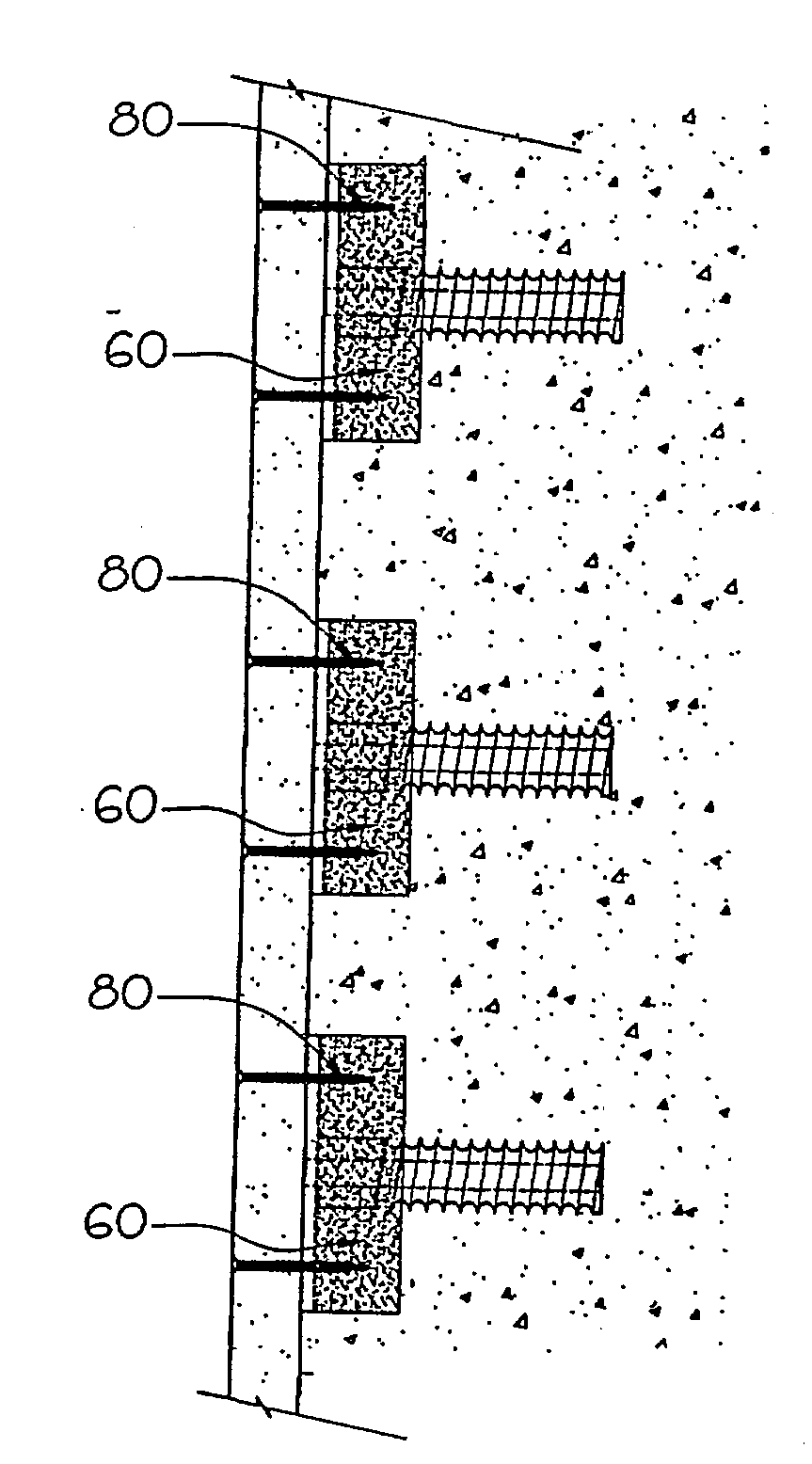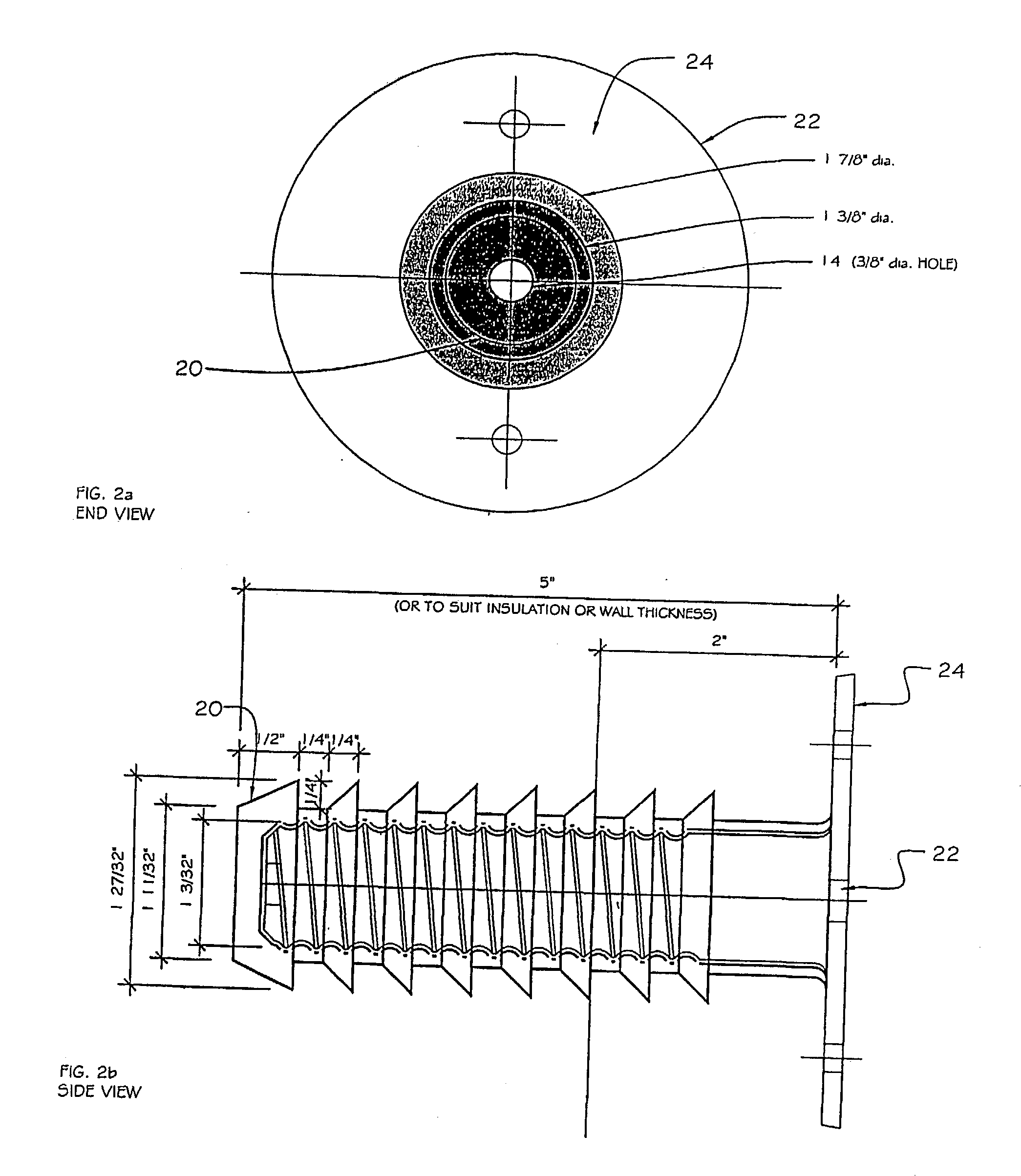The prior art has disadvantages in that:
the break-back of the
metal form tie results in panel surface damage and a requirement to patch;
there is no structural or optionally adjustable fastening surface or means for attachment of other things such as fixtures, handles, carriers, and the like, nor any means of positioning a foam or other barrier during (and after) casting of the panel;
the form ties leave protruding ends to be broken back, requiring additional labor and potential damage to the panel or element.
This complicates the
engineering and
building code considerations due to the structure being considered composite rather than monolithic.
In the field, it is difficult to suspend a barrier within a form without rupture and movement due to head pressures developed by the uneven filling of the divided elements.
This has not become widespread practice due to the difficulty of lacing two forms and up to two
layers of insulation together with the tie acting to restrain all elements from moving relative to one another during the pouring and casting steps.
It is difficult and
time consuming to line up the hole in the form, the (up to) two foam panels and then
close up the forms aligning all the ties with all the holes in the "buttoning up" procedure.
This was further aggravated by the lack of a standard grid matrix that ties and tie holes would be located relative to (and thus the lack of any standard to which foam panels could be produced to fit the grid array of form ties which, when assembled, would pierce the foam layer comprised of the foam panels).
It was also difficult to assure that the insulation panels had not moved out into the concrete void due to all the adjustments required.
Consistent delivery of these required properties in face of the variables involved with the head and
impact pressures of fresh concrete pours is difficult to achieve.
Typically, the practice of vibrating walls with a mechanical immersion vibrator after pour but prior to curing is discouraged due to concerns over possible rupture due to damage caused by contact of the vibrator with the foam forms and also due to concerns for the increase in form pressure brought about by liquefying the concrete through vibration.
Concerns for the complete compaction of the concrete are difficult to quantify or visually inspect, given that all exposed surfaces are covered with foam.
Concerns for water-tightness due to lack of vibratory consolidation arise out of and can be attributed to lack of consolidation around the numerous ties required to reinforce the two (foam) face shells.
Nailing surfaces are not adjustable to overcome these site deficiencies.
This prior art
system is additionally restricted in its use for a number of reasons; it is practical only on exterior walls where
thermal resistance is desired.
The thickness of the exterior shell adds to the overall dimension of the foundation which can effect building lot set backs as well as increasing the total building
footprint.
Thicker walls require changes to a number of building details such as width of window and door sills, etc. and adaptations from standard dimension lumber and finished parts, adding significantly to costs.
Code issues see a requirement for interior insulated surfaces to be covered with a fire rated material, such as
drywall.
In some jurisdictions, the use of a firewall is restricted due to the plastic ties connecting the two wall surfaces present in common commercially produced ICF systems.
The use below grade in most termite areas is restricted or forbidden due to the foam providing a conduit for the insects to enter the home up the outside of the wall under the finishes.
The
system is not in widespread use and the restrictions and problems are not yet documented.
The nailer provided in Martineau is not adjustable.
The drawbacks to this
system were the variability of the wood in terms of the ability to hold the nail, the effect of swelling and shrinking of the block within the hardened concrete pocket, rotting and
insect attack in some geographic areas, and the inability to quantify the
engineering properties of the connection.
The drawbacks are that one cannot drive a nail into a
metal plate and that most attachments were made by either
welding or threading, neither of which is suitable for light cladding or finishing materials.
Plating complicates the connection further due to the effect of destroying this treated surface while drilling or
welding connections to it.
Aluminum was used for a brief while until it was discovered that a reaction between the concrete and aluminum would corrode and weaken the
metal in contact with the
mass.
These complications have resulted in the
retrofitting (after pour and cure of the cast panel) of most light connections in the form of
furring or
strapping.
These are labour intensive manual procedures, especially when performed overhead.
Epoxies and glues are also temperature and
humidity dependent, may be toxic, and are expensive.
All of these procedures also add to the overall thickness of a wall, are subject in the case of steel to rusting, and to the case of wood to rotting, warping, or
insect degradation.
This is a labour intensive procedure and requires skilled labour.
The use of form oil or waxy substrate, the existence of form ridges or imperfections, or a dry carbonated surface, may result in
adhesive failure.
This method is limited due to these factors.
These methods are again labour intensive, weather dependent, difficult or impossible to do overhead and require further shimming in some circumstances to provide uniform bearing or
bedding of the object being anchored to the structure.
 Login to View More
Login to View More 


